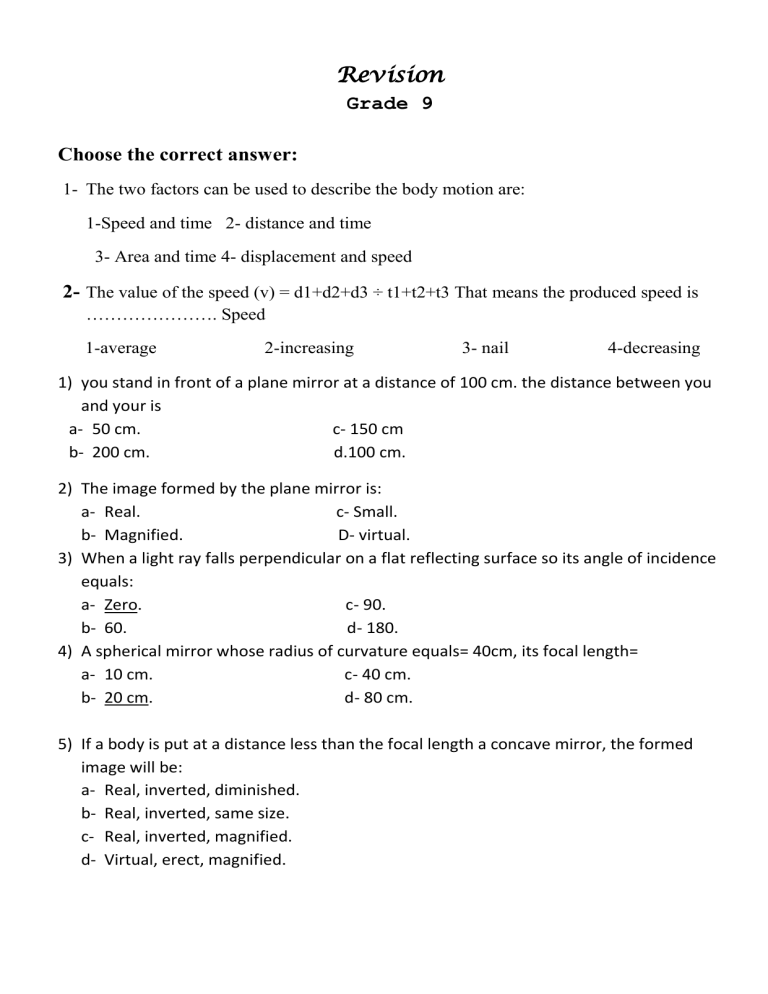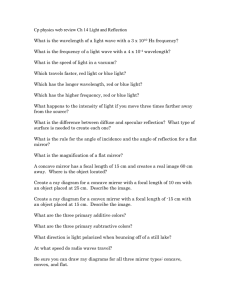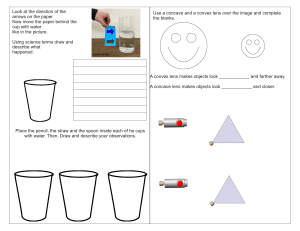
Revision Grade 9 Choose the correct answer: 1- The two factors can be used to describe the body motion are: 1-Speed and time 2- distance and time 3- Area and time 4- displacement and speed 2- The value of the speed (v) = d1+d2+d3 ÷ t1+t2+t3 That means the produced speed is …………………. Speed 1-average 2-increasing 3- nail 4-decreasing 1) you stand in front of a plane mirror at a distance of 100 cm. the distance between you and your is a- 50 cm. c- 150 cm b- 200 cm. d.100 cm. 2) The image formed by the plane mirror is: a- Real. c- Small. b- Magnified. D- virtual. 3) When a light ray falls perpendicular on a flat reflecting surface so its angle of incidence equals: a- Zero. c- 90. b- 60. d- 180. 4) A spherical mirror whose radius of curvature equals= 40cm, its focal length= a- 10 cm. c- 40 cm. b- 20 cm. d- 80 cm. 5) If a body is put at a distance less than the focal length a concave mirror, the formed image will be: a- Real, inverted, diminished. b- Real, inverted, same size. c- Real, inverted, magnified. d- Virtual, erect, magnified. Choose the correct answer: a) Speed measurement units are: 1) Meter. second. 2) Meter/second. 3)Meter/second2 b) Acceleration measurement units are: 1) Meter/second. 2) Meter. second. 3)Meter/second2 c) Displacement is: 1) A scalar and its unit is meter. 2) A vector and its units are meter/second2. 3) A vector and its unit is meter. d) The amount of the change of displacements in one second equals: 1) Velocity. 2) Speed. 3) Acceleration. f ) The object moves at constant uniform speed when: 1) It moves at zero acceleration. 2) It moves at constant acceleration. 3) It covers equal distance at unequal times. g) It is said that the object moves at uniform acceleration when: 1) Its final speed is equal to its primary speed. 2) Its speed increases at equal amounts at equal times. 3) Covers equal distances at equal times. h) Acceleration is : 1) A vector whose units are m/s2. 2) A vector whose units are m/s. 3) A scalar whose units are m/s2. i) The amount of change in speed at a time unit determines: 1) Velocity 2) Displacement 3) Acceleration k) A car moving on a straight line covers a total distance (d) in a total time (t), the average speed of the car is given by: 1) V = t × d 2) V = d / t 3) V = t / d2 ============================================================= Choose: a) If the light ray falls passing through the focus of the concave mirror it will: 1- Reflect parallel to the principal axis. 2- Reflect on itself. 3- Reflect through the centre of curvature. b) A concave mirror with a focal length of 20 cm and the object is placed at a distance of 50 cm from the mirror, the image formed at a distance: 1- More than 40 cm 2- More than 20 cm and less than 40 cm 3- Equal to 20 cm. c) A spherical mirror where its radius is 60 cm, its focal length is equal to. 1- 30 cm 2- 120 cm 3- 60 cm d ) If a light ray falls passing the optical centre of the convex lens it leaves the lens 1- Passing through focus. 2- Parallel to the principal axis. 3-Without refraction. e) A convex lens with a focal length of 20 cm, and an object was placed 40cm from the lens the image of the object is formed at: 1- 40 cm 2- 20 cm 3- 10 cm f) An object when placed at a distance less than the focal length of the convex lens, the characteristics of the image formed are:: 1- Real, inverted, and enlarged. 2- Real, inverted and smaller 3- Virtual, upright, enlarged. g) If a light ray falls parallel to the principal axis of a concave mirror it will. 1- Reflect passing by the spherical centre of the mirror. 2- Reflect passing by the focus. 3- Reflect on itself. h) Place an object at the focus of a convex lens, the position of the formed image will be: 1- Between the focus and spherical center. 2- At the spherical center. 3- The image is not formed.




